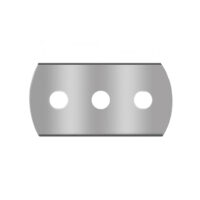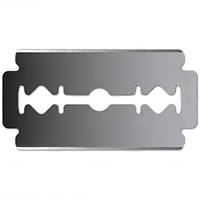What benefits does tungsten carbide provide and what draw backs are there?
Tungsten carbide is the hardest metal there is and it has a smooth surface compared to other metals. Both characteristics help provide a longer life of the blade.
On the other hand Tungsten is relatively brittle when compared to stainless steel and it is therefore relatively vulnerable to breakage when strong forces are applied.
Lower down times: Tungsten carbide blades are somewhat more expensive than steel blades, but in several applications the reduced change over times make it a worthwhile investment.
Why should I add a coating to my blade?
The answer to that question depends on the benefit(s) you are looking for. If you are looking for extended blade life/reduction of change over time, or reduction of friction, a coating, or even a double coating could very well be worthwhile. Please note that coatings will reduce sharpness of blades.
Multilayer Coatings
While tin coatings have proven to be a reliable and cost-effective solution, the world of cutting tool coatings continues to evolve. One emerging trend is the use of multilayer coatings, which combine the benefits of various coating materials and techniques.
Multilayer coatings are used in a wide range of applications where good adhesion of the coating to the base material is crucial, as well as for the application of hard and slippery coatings that reduce friction and do not require perfect cooling. These advanced coating systems can provide enhanced performance characteristics, such as improved wear resistance, reduced friction, and enhanced corrosion protection.
The Tin Coating Advantage
Among the various coating options for industrial blades available, tin (Sn) coatings have emerged as a popular choice, particularly for tungsten carbide blades used in plotter and cutter machines.
Typically, we apply a coating thickness of around 2 microns (μ) to these blades. While the added thickness may slightly compromise the initial sharpness of the blade, this effect is often short-lived. As the blade is used, the tin layer gradually wears down, resulting in a sharper cutting edge and a corresponding reduction in the cutting force required.
When utilizing tin-coated tungsten carbide blades in plotter and cutter machines, we have observed a significant increase in their lifespan, with a minimum extension of 30% (up to 10 x) compared to non-coated blades. This extended lifespan translates to substantial cost savings, as the average price of a tungsten carbide blade is typically increased by only around 10% (ballpark figure tin coating vs tungsten carbide plotter blade) due to the tin coating process.
The real advantage, however, lies in the reduced machine downtime. By extending the lifespan of the cutting blades, operators can enjoy more consistent and reliable performance, minimizing the need for frequent blade replacements and the associated disruptions to production.
What are DLC Blades and what advantages do they have?
 DLC blades are cutting tools that feature a thin layer of Diamond-Like Carbon coating applied to the blade’s surface. DLC is a type of amorphous carbon that exhibits properties similar to those of natural diamond. This coating is deposited onto the blade using specialized techniques like physical vapor deposition (PVD) or chemical vapor deposition (CVD), resulting in a highly durable and wear-resistant surface. Typically advantages of DLC are:
DLC blades are cutting tools that feature a thin layer of Diamond-Like Carbon coating applied to the blade’s surface. DLC is a type of amorphous carbon that exhibits properties similar to those of natural diamond. This coating is deposited onto the blade using specialized techniques like physical vapor deposition (PVD) or chemical vapor deposition (CVD), resulting in a highly durable and wear-resistant surface. Typically advantages of DLC are:
1. Superior Hardness and Durability: The DLC coating significantly enhances the hardness of the blade, surpassing that of traditional blade materials.
2. Reduced Friction and Adhesion: DLC blades have a low coefficient of friction, minimizing frictional resistance during cutting or slicing tasks.
3. Enhanced Cutting Performance.
4. Extended Lifespan.
Advantages of stainless steel blades include corrosion resistance and hardness
 Stainless steel is an alloy of combined iron, carbon, and chromium. It contains at least 10.5% chromium (Cr) by weight. Some stainless steels contain up to 20% chromium. Chromium is the element that makes stainless steel rust- and corrosion-resistant. This element forms a thin layer of chrome oxide and prevents oxygen from penetrating into the steel to cause corrosion.
Stainless steel is an alloy of combined iron, carbon, and chromium. It contains at least 10.5% chromium (Cr) by weight. Some stainless steels contain up to 20% chromium. Chromium is the element that makes stainless steel rust- and corrosion-resistant. This element forms a thin layer of chrome oxide and prevents oxygen from penetrating into the steel to cause corrosion.
Stainless Steel, alloyed with a significant percentage of Chromium, provides excellent corrosion resistance and good hardness and toughness. However, it doesn’t retain an edge as long as Carbon Steel and can be more challenging to sharpen.
Once sharpened, most stainless steel knives will hold an edge longer than standard carbon steel knives. There are however, high-carbon stainless steels that also contain high amounts of vanadium and tungsten to maximize edge retention. These steels are often used to make industrial blades.
Is tungsten carbide recyclable? Yes, it is. How? Leftover, unsharp blades can either be re-sharpened, or collected and melted again. Tungsten carbide can then be recast into many different shapes.
Resharpening can often be done locally, to reduce time and freight costs. It can be done several times, depending on the application.
Do I have to buy blades from the manufacturer of my machine? If you do not have a contract that explicitly stipulates that you do, for instance because it is a prerequisite for support by the manufacturer, than you don’t have to, and you can make use of generic blades or custom designed blades. That freedom could of course provide significant savings. Make sure that you have a precise drawing of the blade for a good fit.

